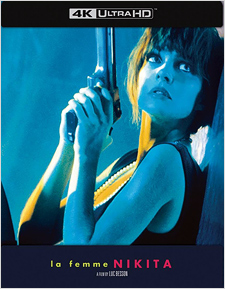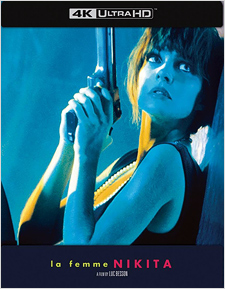La Femme Nikita (Steelbook) (4K UHD Review)

Director
Luc BessonRelease Date(s)
1990 (June 11, 2024)Studio(s)
Gaumont/Les Films Du Loop/Cecchi Gori Group Tiger/Cinematografica/Sony Pictures Classics (Sony Pictures Home Entertainment)- Film/Program Grade: A
- Video Grade: A+
- Audio Grade: B
- Extras Grade: N/A
Review
Luc Besson has made many interesting films over his four decade career, including titles that range from the absurd (Valerian and the City of a Thousand Planets, Lucy) to the sublime (Léon: The Professional, The Big Blue). Some have crashed and burned at the box office (his Arthur CG-animated trilogy), while others continue to delight (The Fifth Element). But none have had a greater impact than his 1990 breakout hit, La Femme Nikita—or simply Nikita, as it’s titled in his native France. Quentin Tarantino has acknowledged the film’s influence on Kill Bill (and the character of “The Cleaner” on Harvey Keitel’s role in Pulp Fiction). La Femme Nikita is oft-copied—including by Besson himself (Anna)—and has been remade by John Badam as Point of No Return (1993), as well as by filmmakers in Hong Kong, South Korea, and Bollywood. It even inspired a pair of English-language TV series (and it’s not hard to imagine that JJ Abrams had Nikita in mind when creating Alias). But while Besson certainly didn’t invent the cinematic female assassin—that credit probably belongs to Toshiya Fujita, the director of Lady Snowblood, as well as writer Kazuo Koike and illustrator Kazuo Kamimura for the 1972 manga that inspired it—Nikita certainly launched the archetype into the modern film consciousness with style and flair.
Following her arrest for the murder of a French police officer during the armed robbery of a pharmacy, the teenage junkie Nikita (Anne Parillaud, Innocent Blood) misbehaves and is quickly convicted and sentenced to prison. Once there, mysterious figures arrive to inject her with something, in what she believes is a death sentence. Instead, she wakes up in a secret facility and is given a choice by a well-dressed man named Bob (Tchéky Karyo, The Messenger): Begin a new life by training as an assassin for the French Government… or refuse knowing that her fake “death” in prison will thus become real. Either way, the life she knew before is over, but then it wasn’t much of a life to begin with. Nikita has a fire within her, so she chooses to take on the challenge. Soon she meets Amanda (Jeanne Moreau, Jules et Jim), who teaches her to embrace her feminine self. She learns computers, trains with weapons, and takes fighting lessons. Three years pass, and the young nihilist gradually transforms into a sophisticated young woman. But while Nikita is now a better person than she was before—smart, cultured, and refined—her debt to society must be repaid. And her purpose is to kill.
Nikita is a terrific film that works for a number of reasons, but foremost among them is the talent of Anne Parillaud, who embodies the title character with breathtaking rage, vulnerability, strength, and a childlike enthusiasm for life in the moment. She’s believable at all times, sympathetic despite her early transgressions, and utterly compelling on screen. At one point early in her training, Nikita begins to realize her own strength and the power of her femininity, and you see her transform within a single shot as she learns how to smile. Upon her release from training, and as she begins to build a new life out in society, the zeal with which she does something so mundane as shopping for groceries is completely charming—you simply can’t help rooting for this girl, no matter what terrible acts she commits. The film’s supporting cast delivers too, including Karyo and Moreau, but also Jean-Hugues Anglade (Betty Blue) as the young man Nikita falls in love with, and of course Jean Reno (Ronin) as the aforementioned “Cleaner,” a role he would essentially reprise in Léon.
Luc Besson is, by some French critics (and not as a compliment) considered a leading member of the Cinéma du look, a quasi film movement of the 1980s and 90s, akin to the New Hollywood of a decade earlier, that is claimed to emphasize style over substance, alienated youth, anti-establishment themes, and the mixing of high and pop culture. Nikita certainly embraces some of these characteristics, though to dismiss the film for that smacks of snobbery. Besson’s here direction is deft and efficient, the cinematography and lighting by frequent Besson collaborator Thierry Arbogast (Léon, The Fifth Element) are vibrant and evocative, the editorial pace is adaptive—alternately snappy or languid and always ahead of the curve in a way that combines with the camerawork and Éric Serra’s electronic music to really drive the film forward. And though many works have attempted to emulate its success—Atomic Blonde, Hanna, Wanted, The Villainess, Gunpowder Milkshake, Ava, Salt, Gunslinger Girl, The Long Kiss Goodnight, Red Sparrow, and more—none have yet eclipsed it.
La Femme Nikita was shot on 35 mm photochemical film by Arbogast using Arriflex 35 cameras with Technovision (and likely Zeiss Super Speed and Angenieux HR) anamorphic lenses, and it was released theatrically framed at the 2.39:1 scope aspect ratio. For its Ultra HD debut, Sony has taken advantage of a new 4K scan of the original camera negative and restoration produced by Gaumont and Video Digital Multimedia in France, which includes high dynamic range color grading (both Dolby Vision and HDR10 are available). It’s encoded on a 66 GB disc, with data rates that average around 60 Mbps. The image exhibits impressive texturing and crisp detail, with the usual touch of anamorphic softness around the edges of the frame. The color palette is truly stunning—richly saturated and accurate, with the expanded gamut allowing far greater nuance that is apparent on Sony’s 2008 Blu-ray release. Reds, blues, and greens in the film’s opening sequence are so bold as to pop off the screen. Shadows are deeply black, highlights are more intense, and both retain a bit more detail than they do in HD. Photochemical grain is on the medium side of light, but appears natural and organic. This is an absolutely gorgeous presentation.
Audio-wise, the 4K disc offers lossless DTS-HD Master Audio in the original French 2.0 as well as 5.1. There’s a dubbed English 5.1 mix too, also in DTS-HD MA. The French tracks are obviously the preferred option, though both are a little wonky. The film was released in theaters with a Dolby Stereo Matrix soundtrack, so it appears that Gaumont has simply converted that source to 5.1 (which is really just 5.0). But there’s a crisp, airy rapport missing from the gunshots here. Strangely, other sound effects—the axe strike on the drugstore door, the police car screeching up—are not affected. But the gunshots have a more muffled quality here in both French 5.1 and 2.0 than they do in the dubbed English 5.1 track. The previous Sony Blu-ray’s French 5.1 track (which was encoded in Dolby TrueHD format) was not so affected, which suggests that Gaumont created new mixes from the original audio elements for this release. Perhaps something they did impacted the gunshot sound effects, or it may be that Sony simply “sweetened” their 2008 BD mixes—and it’s their BD English 5.1 that carries over to this new 4K disc. (A quick check of the 2004 MGM DVD reveals the French 5.1 to be a little muddy there as well.) Given Gaumont’s involvement, I can’t really say which mix is right or wrong. And to be fair, it’s not something you’d be likely to notice if you weren’t doing AB comparisons to check the video (as I was). But once you compare these mixes (and you can do it right on the 4K disc with the touch of a button), the difference is readily apparent. In any case, dialogue on all of these new mixes is crisp and clear, there’s a decent amount of bass (despite the lack of actual LFE engagement), and Serra’s moody and rhythmic synth score sounds fantastic. Subtitles options include English, English SDH, and Spanish.
Sony’s new 4K edition delivers a single UHD disc in Steelbook packaging. No Blu-ray is included, nor are there any special features. To be fair, Sony’s 2008 Blu-ray also had no features. The MGM DVD release did include some extras however, so you may wish to keep that disc if you have it. Among them were The Sound of Nikita (SD – 4:49), Revealed: The Making of La Femme Nikita (SD – 20:37), Programming Nikita (SD – 3 parts – 1:43 in all), a Poster Gallery (SD – 2 images), a Theatrical Trailer (SD – 2:19), and an Easter Egg (SD – :27). Unfortunately, there’s also no Digital code here—this is a bare bones release.
Though one might fault Besson for his personal proclivities, which have been well documented elsewhere, there can be no arguing that La Femme Nikita is anything other than a terrific action thriller, bursting with glossy, neo-noir aesthetics. Parillaud’s performance is stunning—you simply can’t take your eyes off her. Nikita pulses with energy from start to finish. Sony’s new 4K Ultra HD release, apart from a minor audio issue (for which Gaumont is likely responsible), delivers it in very pleasing quality.
- Bill Hunt
(You can follow Bill on social media at these links: Twitter and Facebook)

